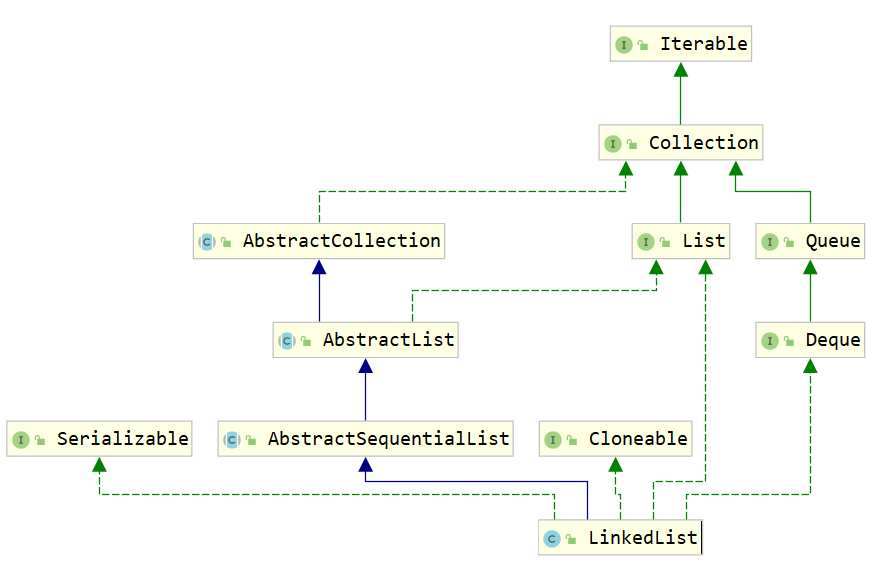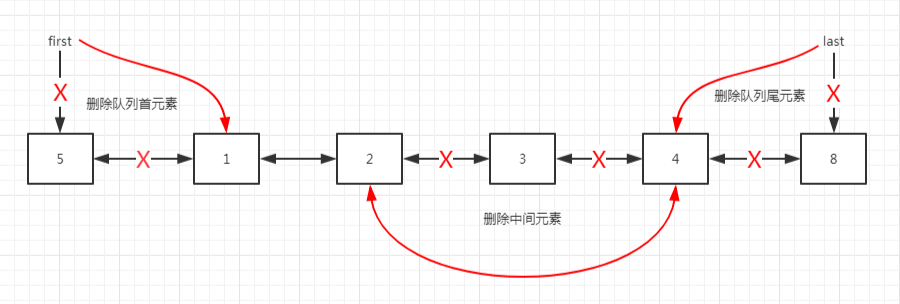问题
(1)LinkedList只是一个List吗?
(2)LinkedList还有其它什么特性吗?
(3)LinkedList为啥经常拿出来跟ArrayList比较?
简介
LinkedList是一个以双向链表实现的List,它除了作为List使用,还可以作为队列或者栈来使用,它是怎么实现的呢?
继承体系

通过继承体系,我们可以看到LinkedList不仅实现了List接口,还实现了Queue和Deque接口,所以它既能作为List使用,也能作为双端队列使用,当然也可以作为栈使用。
源码分析
主要属性
// 元素个数
transient int size = 0;
/**
* Pointer to first node.
* Invariant: (first == null && last == null) ||
* (first.prev == null && first.item != null)
*
* 链表首节点
*/
transient Node<E> first;
/**
* Pointer to last node.
* Invariant: (first == null && last == null) ||
* (last.next == null && last.item != null)
*
* 链表尾节点
*/
transient Node<E> last;属性很简单,定义了元素个数size和链表的首尾节点。
主要内部类
典型的双链表结构:
private static class Node<E> {
E item;
Node<E> next;
Node<E> prev;
Node(Node<E> prev, E element, Node<E> next) {
this.item = element;
this.next = next;
this.prev = prev;
}
}主要构造方法
/**
* Constructs an empty list.
*/
public LinkedList() {
}
/**
* Constructs a list containing the elements of the specified
* collection, in the order they are returned by the collection's
* iterator.
*
* @param c the collection whose elements are to be placed into this list
* @throws NullPointerException if the specified collection is null
*/
public LinkedList(Collection<? extends E> c) {
this();
addAll(c);
}两个构造方法也很简单,可以看出是一个无界的队列。
添加元素
作为一个双端队列,添加元素主要有两种,一种是在队列尾部添加元素,一种是在队列首部添加元素,这两种形式在LinkedList中主要是通过下面两个方法来实现的。
/**
* Links e as first element.
* 从队列首添加元素
*/
private void linkFirst(E e) {
// 首节点
final Node<E> f = first;
// 创建新节点,新节点的next是首节点
final Node<E> newNode = new Node<>(null, e, f);
// 让新节点作为新的首节点
first = newNode;
// 判断是不是第一个添加的元素,如果是就把last也置为新节点,否则把原首节点的prev指针置为新节点
if (f == null)
last = newNode;
else
f.prev = newNode;
// 元素个数加1
size++;
// 修改次数加1,说明这是一个支持fail-fast的集合
modCount++;
}
/**
* Links e as last element.
* 从队列尾添加元素
*/
void linkLast(E e) {
// 队列尾节点
final Node<E> l = last;
// 创建新节点,新节点的prev是尾节点
final Node<E> newNode = new Node<>(l, e, null);
// 让新节点成为新的尾节点
last = newNode;
// 判断是不是第一个添加的元素,如果是就把first也置为新节点,否则把原尾节点的next指针置为新节点
if (l == null)
first = newNode;
else
l.next = newNode;
// 元素个数加1
size++;
// 修改次数加1
modCount++;
}
/**
* Inserts the specified element at the beginning of this list.
*
* @param e the element to add
*/
public void addFirst(E e) {
linkFirst(e);
}
/**
* Appends the specified element to the end of this list.
*
* <p>This method is equivalent to {@link #add}.
*
* @param e the element to add
*/
public void addLast(E e) {
linkLast(e);
}
// Deque operations
/**
* Inserts the specified element at the front of this list.
* 作为无界队列,添加元素总是会成功的
*
* @param e the element to insert
* @return {@code true} (as specified by {@link Deque#offerFirst})
* @since 1.6
*/
public boolean offerFirst(E e) {
addFirst(e);
return true;
}
/**
* Inserts the specified element at the end of this list.
*
* @param e the element to insert
* @return {@code true} (as specified by {@link Deque#offerLast})
* @since 1.6
*/
public boolean offerLast(E e) {
addLast(e);
return true;
}典型的双链表在首尾添加元素的方法了。
上面是作为双端队列来看,它的添加元素分为首尾添加元素,那么,作为List呢?
作为List,是要支持在中间添加元素的,主要是通过下面这个方法实现的。
/**
* Inserts element e before non-null Node succ.
* 在节点succ之前添加元素
*/
void linkBefore(E e, Node<E> succ) {
// assert succ != null;
// succ是待添加节点的后继节点 , 找到待添加节点的前置节点
final Node<E> pred = succ.prev;
// 在其前置节点和后继节点之间创建一个新节点
final Node<E> newNode = new Node<>(pred, e, succ);
// 修改后继节点的前置指针指向新节点
succ.prev = newNode;
// 判断前置节点是否为空,如果为空,说明是第一个添加的元素,修改first指针,否则修改前置节点的next为新节点
if (pred == null)
first = newNode;
else
pred.next = newNode;
// 修改元素个数
size++;
// 修改次数加1
modCount++;
}
/**
* Returns the (non-null) Node at the specified element index.
* 寻找index位置的节点
*/
Node<E> node(int index) {
// assert isElementIndex(index);
// 因为是双链表,所以根据index是在前半段还是后半段决定从前遍历还是从后遍历
// 这样index在后半段的时候可以少遍历一半的元素
if (index < (size >> 1)) {
// 如果是在前半段,就从前遍历
Node<E> x = first;
for (int i = 0; i < index; i++)
x = x.next;
return x;
} else {
// 如果是在后半段, 就从后遍历
Node<E> x = last;
for (int i = size - 1; i > index; i--)
x = x.prev;
return x;
}
}
/**
* Inserts the specified element at the specified position in this list.
* Shifts the element currently at that position (if any) and any
* subsequent elements to the right (adds one to their indices).
* 在指定index位置处添加元素
*
* @param index index at which the specified element is to be inserted
* @param element element to be inserted
* @throws IndexOutOfBoundsException {@inheritDoc}
*/
public void add(int index, E element) {
// 判断是否越界
checkPositionIndex(index);
// 如果index是在队列尾节点之后的一个位置
// 把新节点直接添加到尾节点之后
// 否则调用linkBefore()方法在中间添加节点
if (index == size)
linkLast(element);
else
linkBefore(element, node(index));
}在中间添加元素的方法,典型的双链表在中间添加元素的方法。
添加元素的三种方式大致如下图所示:

在队列首尾添加元素很高效,时间复杂度为O(1)。
在中间添加元素比较低效,首先要先找到插入位置的节点,再修改前后节点的指针,时间复杂度为O(n)。
删除元素
作为双端队列,删除元素也有两种方式,一种是队列首删除元素,一种是队列尾删除元素。
作为List,又要支持中间删除元素,所以删除元素一个有三个方法,分别如下:
/**
* Unlinks non-null first node f.
* 删除首节点
*/
private E unlinkFirst(Node<E> f) {
// assert f == first && f != null;
// 首节点的元素值
final E element = f.item;
// 首节点的next指针
final Node<E> next = f.next;
// 添加首节点的内容,协助GC
f.item = null;
f.next = null; // help GC
// 把首节点的next作为新的首节点
first = next;
// 如果只有一个元素,删除了,把last也置为空,否则把next的前置指针置为空
if (next == null)
last = null;
else
next.prev = null;
// 元素个数减1
size--;
// 修改次数加1
modCount++;
// 返回删除的元素
return element;
}
/**
* Unlinks non-null last node l.
* // 删除尾节点
*/
private E unlinkLast(Node<E> l) {
// assert l == last && l != null;
// 尾节点的元素值
final E element = l.item;
// 尾节点的前置指针
final Node<E> prev = l.prev;
// 清空尾节点的内容,协助GC
l.item = null;
l.prev = null; // help GC
// 让前置节点成为新的尾节点
last = prev;
// 如果只有一个元素,删除了把first置为空
// 否则把前置节点的next置为空
if (prev == null)
first = null;
else
prev.next = null;
// 元素个数减1
size--;
// 修改次数加1
modCount++;
// 返回删除的元素
return element;
}
/**
* Unlinks non-null node x.
* 删除指定节点x
*/
E unlink(Node<E> x) {
// assert x != null;
// x的元素值
final E element = x.item;
// x的前置节点
final Node<E> next = x.next;
// x的后置节点
final Node<E> prev = x.prev;
// 如果前置节点为空,说明是首节点,让first指向x的后置节点,否则修改前置节点的next为x的后置节点
if (prev == null) {
first = next;
} else {
prev.next = next;
x.prev = null;
}
// 如果后置节点为空,说明是尾节点,让last指向x的前置节点, 否则修改后置节点的prev为x的前置节点
if (next == null) {
last = prev;
} else {
next.prev = prev;
x.next = null;
}
// 清空x的元素值,协助GC
x.item = null;
// 元素个数减1
size--;
// 修改次数加1
modCount++;
// 返回删除的元素
return element;
}
/**
* Removes and returns the first element from this list.
* remove的时候如果没有元素抛出异常
*
* @return the first element from this list
* @throws NoSuchElementException if this list is empty
*/
public E removeFirst() {
final Node<E> f = first;
if (f == null)
throw new NoSuchElementException();
return unlinkFirst(f);
}
/**
* Removes and returns the last element from this list.
* remove的时候如果没有元素抛出异常
*
* @return the last element from this list
* @throws NoSuchElementException if this list is empty
*/
public E removeLast() {
final Node<E> l = last;
if (l == null)
throw new NoSuchElementException();
return unlinkLast(l);
}
/**
* Retrieves and removes the first element of this list,
* or returns {@code null} if this list is empty.
* poll的时候如果没有元素返回null
*
* @return the first element of this list, or {@code null} if
* this list is empty
* @since 1.6
*/
public E pollFirst() {
final Node<E> f = first;
return (f == null) ? null : unlinkFirst(f);
}
/**
* Retrieves and removes the last element of this list,
* or returns {@code null} if this list is empty.
* poll的时候如果没有元素返回null
*
* @return the last element of this list, or {@code null} if
* this list is empty
* @since 1.6
*/
public E pollLast() {
final Node<E> l = last;
return (l == null) ? null : unlinkLast(l);
}
/**
* Removes the element at the specified position in this list. Shifts any
* subsequent elements to the left (subtracts one from their indices).
* Returns the element that was removed from the list.
* 删除中间节点
*
* @param index the index of the element to be removed
* @return the element previously at the specified position
* @throws IndexOutOfBoundsException {@inheritDoc}
*/
public E remove(int index) {
// 检查是否越界
checkElementIndex(index);
// 删除指定index位置的节点
return unlink(node(index));
}删除元素的三种方法都是典型的双链表删除元素的方法,大致流程如下图所示:

在队列首尾删除元素很高效,时间复杂度为O(1)。
在中间删除元素比较低效,首先要找到删除位置的节点,再修改前后指针,时间复杂度为O(n)。
栈
LinkedList是双端队列,双端队列可以作为栈使用:
/**
* Pushes an element onto the stack represented by this list. In other
* words, inserts the element at the front of this list.
*
* <p>This method is equivalent to {@link #addFirst}.
*
* @param e the element to push
* @since 1.6
*/
public void push(E e) {
addFirst(e);
}
/**
* Pops an element from the stack represented by this list. In other
* words, removes and returns the first element of this list.
*
* <p>This method is equivalent to {@link #removeFirst()}.
*
* @return the element at the front of this list (which is the top
* of the stack represented by this list)
* @throws NoSuchElementException if this list is empty
* @since 1.6
*/
public E pop() {
return removeFirst();
}栈的特性是LIFO(Last In First Out),所以作为栈使用也很简单,添加删除元素都只操作队列首节点即可
总结
(1)LinkedList是一个以双链表实现的List;
(2)LinkedList还是一个双端队列,具有队列、双端队列、栈的特性;
(3)LinkedList在队列首尾添加、删除元素非常高效,时间复杂度为O(1);
(4)LinkedList在中间添加、删除元素比较低效,时间复杂度为O(n);
(5)LinkedList不支持随机访问,所以访问非队列首尾的元素比较低效;
(6)LinkedList在功能上等于ArrayList + ArrayDeque;


评论加载中